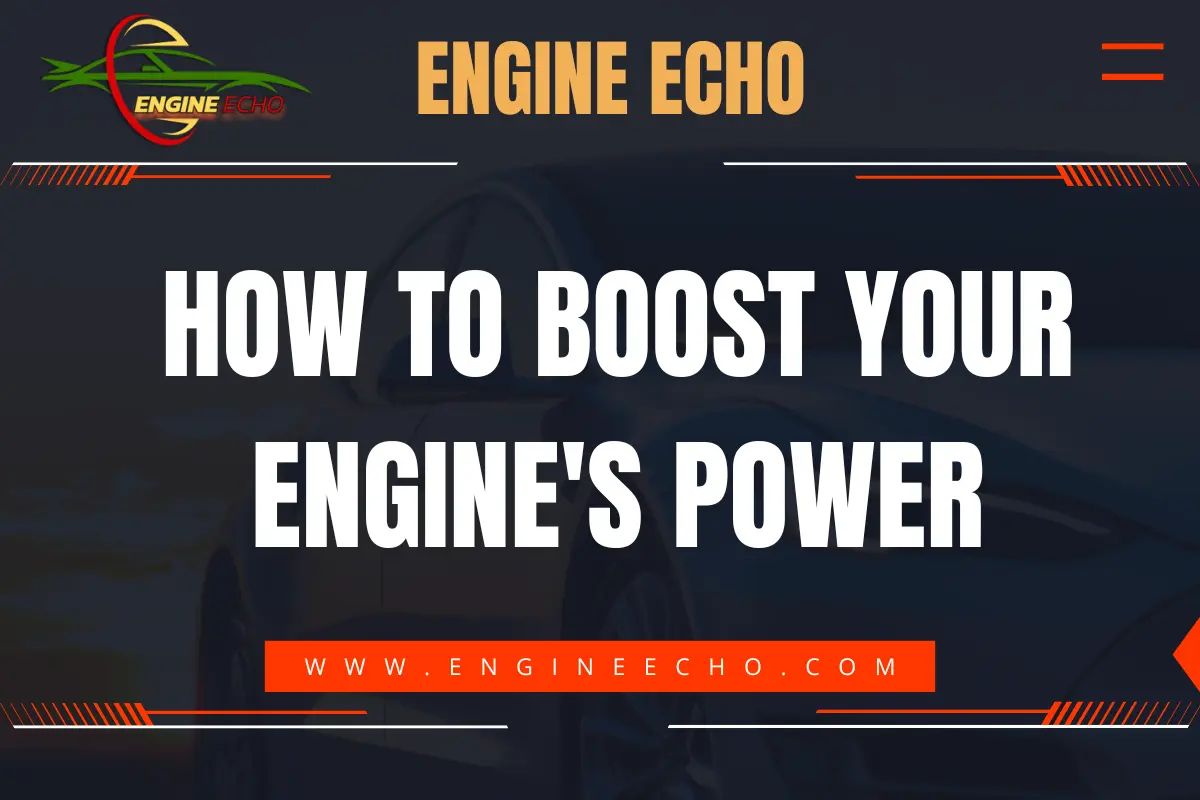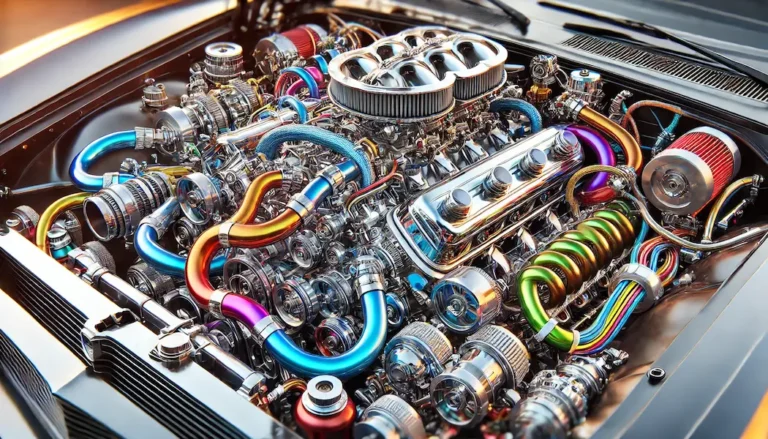How to Boost Your Engine’s Power

Key Takeaways:
- Engine modifications like cold air intakes, exhaust upgrades, and forced induction systems can significantly enhance engine performance.
- Turbochargers and superchargers provide dramatic power gains by increasing the amount of air entering the engine, resulting in more efficient combustion.
- ECU tuning ensures that engine modifications are optimized for the best performance and fuel efficiency.
- Upgrading internal components, such as pistons and camshafts, strengthens the engine’s ability to handle increased power output.
- Regular maintenance, including oil changes, air filter cleaning, and fuel system checks, is critical for maintaining power gains and ensuring longevity.
Introduction
If you’re anything like me, you know that boosting your engine’s power isn’t just about speed—it’s about feeling that surge of torque when you hit the gas and knowing your car is responding just the way you want. Whether you’re after quicker acceleration or more muscle for towing, there are plenty of ways to give your engine the extra kick it needs.
Over the years, I’ve tried everything from basic mods to advanced setups. Some worked wonders, while others, well, let’s just say I learned what not to do the hard way. In this guide, I’m going to share what’s really worked for me—things that’ll help you unlock more power while keeping your engine running smoothly.
1. Understanding Engine Power
Before we dive into specific mods, let’s talk about what we’re really chasing: horsepower and torque. These are the two pillars of engine performance.
- Horsepower: This is basically how fast your car can go. More horsepower means your car can do more work in less time—think higher top speeds.
- Torque: This is your engine’s muscle. Torque is what gets you moving quickly, giving you that punchy acceleration.
For me, torque has always been the most exciting part. Sure, high horsepower is great for bragging rights, but torque is what really throws you back in your seat when you mash the pedal.
2. Basic Modifications for Boosting Engine Power
Cold Air Intakes
One of the easiest mods to start with is a cold air intake. Not only does it give your engine a breath of fresh, cool air, but you’ll feel the difference the moment you hit the throttle. I remember the first time I added one—it was like my engine woke up and asked for more.
- Benefits:
- More dense, cool air means better combustion.
- Adds a small horsepower boost (typically 5-10 HP).
- Affordable and quick to install—great for beginners.
Exhaust System Upgrades
Swapping out your exhaust system for a performance setup was one of my earliest mods, and I’ll tell you—it was worth every penny. Not only did my car sound ten times better, but I also got a noticeable power bump.
- Performance Exhaust Systems Include:
- Headers to improve exhaust flow.
- Cat-back systems to reduce backpressure.
- Benefits: Better flow, improved horsepower (10-20 HP), and a throatier engine sound.
3. Advanced Modifications for Significant Power Gains
Turbochargers
Now, when it comes to real power boosts, turbochargers are a game-changer. They crank up the amount of air your engine gets, letting it burn more fuel and, in turn, giving you a serious performance boost. The first time I felt the surge from my turbo kicking in—well, let’s just say I was hooked.
- How Turbochargers Work: They use exhaust gases to spin a turbine, compressing air into the engine.
- Pros:
- Huge power gains, boosting horsepower by 30-50%.
- Improved fuel efficiency at lower speeds.
- Cons: Adds complexity to your engine, so you’ll need to keep an eye on cooling and maintenance.
Superchargers
If you prefer instant power without the lag of a turbo, superchargers might be your go-to. Personally, I lean more toward turbos because I like that high-RPM punch, but superchargers have their perks, especially for daily drivers looking for that immediate boost.
- Difference from Turbochargers: Superchargers are belt-driven and provide instant power, making them great for quick acceleration.
Nitrous Oxide (NOS) Systems
While I haven’t personally dabbled in nitrous oxide (NOS), I’ve seen it work wonders at the track. It’s like a shot of adrenaline for your engine, giving you massive bursts of power when you need it.
- Benefits: Up to 100 HP gains, especially useful in short bursts for racing.
- Safety Concerns: Use with care—if not handled properly, nitrous can wreak havoc on your engine.
4. Engine Tuning and Remapping
ECU Tuning
One of the most important steps in getting the most out of your mods is ECU tuning. After I installed a turbocharger, getting the ECU remapped was a game-changer. It made sure all the new parts worked together, optimizing fuel delivery and timing for max performance.
- Benefits:
- Unlocks more horsepower and torque.
- Tailors performance to your specific mods.
- Pro Tip: Get a professional tune or invest in a quality tuner if you’re doing it yourself. It’s worth it.
Aftermarket Programmers and Chips
I’ve played around with aftermarket chips too, and while they don’t offer the precision of a full tune, they’re a good starting point if you’re looking for moderate gains without going all in.
5. Upgrading Internal Engine Components
Pistons, Crankshafts, and Connecting Rods
If you’re chasing serious power, upgrading internal components is a must. I’ve learned that the hard way—pushing stock internals too far can quickly lead to disaster.
- Stronger Components: Forged pistons, rods, and cranks can handle the stress of a high-power engine, especially when using forced induction like turbos or superchargers.
Camshaft Upgrades
For those of you aiming to really unlock your engine’s potential, a camshaft upgrade is the way to go. It changes the timing of your valves, letting more air into the engine, which equals more power.
- Best for: High-performance setups, especially for track days or drag racing.
6. Optimizing the Air-Fuel Mixture
Fuel Injectors and Fuel Pumps
After adding a turbo, I realized my stock fuel system just couldn’t keep up. Upgrading to high-flow fuel injectors was essential to match the increased air intake.
- When to Upgrade: If you’ve increased airflow significantly (via turbo or supercharger), your fuel system needs to keep up.
High-Flow Fuel Injectors
These larger injectors deliver more fuel, ensuring your engine gets the optimal air-fuel mixture for high-power setups.
7. Cooling System Upgrades
Intercoolers for Turbocharged/Supercharged Engines
Intercoolers are an absolute must if you’re running forced induction. After adding a turbo, the heat was real—until I installed a front-mount intercooler. It helped keep intake temps down, which meant more consistent power and less risk of overheating.
Radiator Upgrades
If you’re pushing your engine hard, especially with mods like turbochargers or superchargers, upgrading your radiator will keep things cool. I’ve upgraded mine, and the peace of mind knowing my engine won’t overheat is worth it.
Oil Coolers
Adding an oil cooler is another smart move, especially if you’re into high-performance driving. It keeps your engine oil at optimal temperatures, protecting the engine when it’s under heavy load.
8. Lightening the Vehicle for Improved Power-to-Weight Ratio
Reducing Weight
One of the easiest ways to boost performance without touching the engine is by reducing weight. I removed unnecessary components and switched to lighter materials in my car—it’s a night-and-day difference in how quickly it responds.
- Strategies:
- Remove heavy, unused parts (like rear seats or spare tires).
- Upgrade to lightweight components, like carbon fiber or aluminum parts.
Lightweight Wheels and Suspension Components
Reducing unsprung weight (the weight not supported by the suspension, like wheels and brakes) makes a noticeable difference in acceleration and handling. I switched to lightweight wheels, and the improvement in both performance and fuel efficiency was immediate.
9. Transmission and Drivetrain Upgrades
Performance Clutches and Flywheels
With all the extra power you’re adding, your clutch and flywheel need to be able to handle it. I burned through a stock clutch after adding a turbo, so upgrading to a performance clutch and lightweight flywheel was a no-brainer.
- Benefits: Faster, smoother shifting and better power transfer to the wheels.
Limited Slip Differentials (LSD)
An LSD is a must if you’re driving a high-power car. It helps distribute power more evenly between the wheels, giving you better traction, especially in turns. For me, adding an LSD made a huge difference in how my car handles under high power.
10. The Role of Regular Maintenance in Sustaining Power Gains
Oil Changes
Using high-performance oils has become a habit for me, especially after making significant modifications. It’s essential to protect the engine from the added stress of increased power.
Fuel System Cleaning
If you want your engine to keep performing at its best, regular fuel system cleaning is a must. I do this periodically, and it ensures that my fuel injectors and pumps are always delivering maximum performance.
Air Filter Maintenance
Regularly cleaning or replacing your air filter ensures your engine is getting the airflow it needs to maintain power. It’s a small step that makes a big difference.
11. Case Studies
Case Study 1: Turbocharging a Small Engine
I turbocharged my daily driver, a 1.6L engine, and saw an incredible jump in power—from 120 to 200 HP. After adding a front-mount intercooler and tuning the ECU, the car felt like a completely different beast.
Case Study 2: Muscle Car Power Upgrades
I also worked on a classic muscle car, upgrading its camshaft and exhaust system. The result was a powerful 80 HP increase, making the car more responsive and aggressive on the throttle.
Conclusion
For me, the joy of modifying engines comes from seeing the tangible improvements on the road. Whether you’re just starting out or going all-in with forced induction, there’s always something new to learn. I recommend beginning with simple modifications like a cold air intake and ECU tune, which offer significant performance boosts without breaking the bank. And as always, regular maintenance is key to keeping your engine running smoothly as you push it to new heights.
Frequently Asked Questions (FAQs)
- What is the easiest way to increase engine power?
- Installing a cold air intake or upgrading the exhaust system are the easiest and most affordable ways to increase power.
- How much horsepower can I gain from a cold air intake?
- Cold air intakes typically provide a 5-10 horsepower boost, depending on the vehicle.
- Are turbochargers or superchargers better for street cars?
- Turbochargers are often more fuel-efficient, while superchargers provide immediate power. The choice depends on your driving needs.
- How can ECU tuning improve my engine’s performance?
- ECU tuning optimizes fuel and air delivery, allowing your engine to perform more efficiently, resulting in increased horsepower and torque.
- Is it necessary to upgrade internal components for big power gains?
- Yes, upgrading internal components like pistons and crankshafts is essential when aiming for large power gains, especially with forced induction systems.
Thanks for checking out this article on EngineEcho.com! Hope you found this article: "How to Boost Your Engine’s Power" helpful! If you liked it and want to dive into more car engine topics, head over to our homepage. There's always something new to discover in the world of engines. Enjoy your reading journey!
Check out our previous article: Top RC Nitro Engines for Speed Enthusiasts






